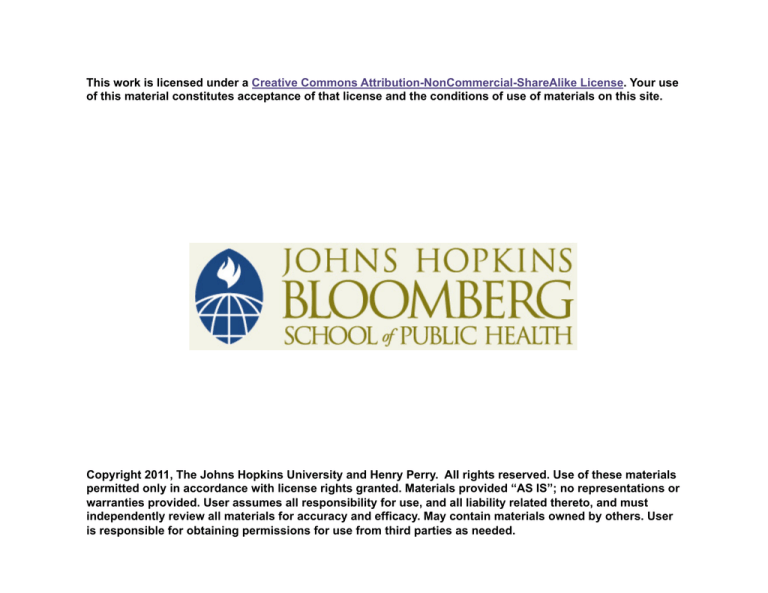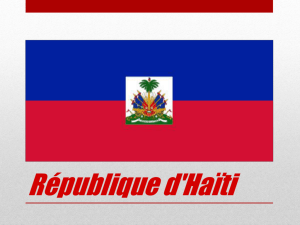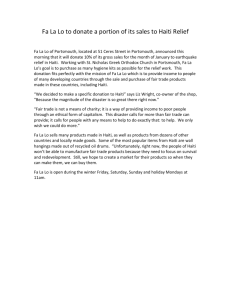
This work is licensed under a Creative Commons Attribution-NonCommercial-ShareAlike License. Your use
of this material constitutes acceptance of that license and the conditions of use of materials on this site.
Copyright 2011, The Johns Hopkins University and Henry Perry. All rights reserved. Use of these materials
permitted only in accordance with license rights granted. Materials provided “AS IS”; no representations or
warranties provided. User assumes all responsibility for use, and all liability related thereto, and must
independently review all materials for accuracy and efficacy. May contain materials owned by others. User
is responsible for obtaining permissions for use from third parties as needed.
Section B
CLAS and Peru, Guatemala, and Haiti
The CLAS Shared Administration Program in Peru
CLAS: local health administration
committee
Legally created by presidential decree
in 1994
Peru
South
America
3
The CLAS Shared Administration Program in Peru
CLAS: local health administration
committee
Legally created by presidential decree
in 1994
Each CLAS has six elected community
members and the primary health care
facility chief
Each CLAS signs a contract with the
Regional MOH health office
One-third of 6,766 MOH primary care
facilities are now administered by CLAS
Peru
South
America
4
Quechua Women
Photo: Future Generations
5
Maps in Houses
Photo: Future Generations
6
Forms of Citizen Participation in CLAS
Administration of resources transferred from the state
Decisions on the use of fees-for-services
Contracting and control of personnel
Quality control of health care
Supervision and control of activities within health facility
Evaluation of management
Health facility maintenance and security
7
Forms of Citizen Participation in CLAS
Community diagnosis: help with local health census
Planning: review and approval of local health plan
Monitoring implementation of local health plan
Support promotional activities
Communicate directly with people to convince them to attend
health facility
Mobilization of additional resources
8
CBIO in Guatemala
CBIO in Guatemala
9
The Project Area
Photos: Henry Perry
10
The Project
Photos: Henry Perry
11
Community Maps
Photos: Henry Perry
12
Care Group Meeting
Photo: Henry Perry
13
Antibiotics
Percentage of Children 0–23 Months of Age with Cough and
Fast/Difficult Breathing Who Were Taken to a Health Facility
or Who Received Antiobiotics from an Alternative Source
Data source: Curamericas Global, LLC
14
Oral Rehydration and Recommended Home Fluids
Percentage of Children 0–23 Months of Age with Diarrhea Who
Received Oral Rehydration (ORS) and/or Recommended Home Fluids
(RHFs)
Data source: Curamericas Global, LLC
15
Tetanus Toxoid Immunizations
Percentage of Mothers Receiving at Least Two Tetanus Toxoid
Immunizations Prior to the Birth of Her Child
Data source: Curamericas Global, LLC
16
Trends in Under-Five Mortality Rate
Trends in Under-Five Mortality Rate by Municipality and Year:
2002–2007, San Sebastian
Data source: Curamericas Global, LLC
17
Maternal Mortality
Maternal Mortality Ratio by Year: 2002–2007
Data source: Curamericas Global, LLC
18
Age at Death among Live-Born Children
Age at Death among Live-Born Children in the Curamericas/
Guatemala Child Survival Project Area, 2002–2005
Data source: Curamericas Global, LLC
19
The Hospital Albert Schweitzer in Haiti
More than a hospital
20
Haiti: Basic Statistics
Topic/issue
In Haiti
Population
8.8 million
GNP per capita
US$ 250
Adult illiteracy rate
47%
Infant mortality
86 deaths per 1,000 live births
Maternal mortality
600 maternal deaths per 100,000 births
HIV prevalence
Urban: 7–10%; rural: 3–5%
Tuberculosis
500 cases per 100,000 population
21
Dr. Albert Schweitzer in Lambaréné
Photo: Hôpital Albert Schweitzer Haiti. Permission requested.
22
Gwen Mellon, Dr. Schweitzer, and Larry Mellon
Photo: Hôpital Albert Schweitzer Haiti. Permission requested.
23
Map of Haiti and the Caribbean
24
Island of Hispaniola, Haiti
25
Market Day
Photo: Hôpital Albert Schweitzer Haiti. Permission requested.
26
Typical House: One Room for a Large Family
Photo: Hôpital Albert Schweitzer Haiti. Permission requested.
27
Gwen and Larry Mellon in the Pediatric Clinic
Photo: Hôpital Albert Schweitzer Haiti. Permission requested.
28
Warren and Gretchen Berggren
Photo: Hôpital Albert Schweitzer Haiti. Permission requested.
29
Neonatal Tetanus Was Eradicated
Photo: Hôpital Albert Schweitzer Haiti. Permission requested.
30
Malnutrition with Tuberculosis
Photo: Hôpital Albert Schweitzer Haiti. Permission requested.
31
Surgery Was a Basic Service at HAS
Photo: Hôpital Albert Schweitzer Haiti. Permission requested.
32
Community Health Agents Giving Immunizations
Photo: Hôpital Albert Schweitzer Haiti. Permission requested.
33
Community Health Center in Artibonite Valley
Photo: Hôpital Albert Schweitzer Haiti. Permission requested.
34
Community Development
The first major project
was to bring potable
water to villages by
capping fresh mountain
springs and piping the
pure water to newly
constructed fountains
Photo: Hôpital Albert Schweitzer Haiti. Permission requested.
35
Gwen Grant Mellon
Photo: Hôpital Albert Schweitzer Haiti. Permission requested.
36
Hospital Albert Schweitzer: More than a Hospital
Serving a population of 285,000 persons
District hospital of 180 beds and 300 employees
Community health program with 200 employees
Community development program with 75 employees
37
Division of Community Health
Serves 185,000 persons
- The other 100,000 persons in the district receive primary health
care services from three other organizations
Seven health centers/dispensaries
Mobile clinics and rally posts
Home visits to all households every two months
38
Division of Community Health
Community-based rehabilitation program
- Ti Foyer, also known as the Hearth Model
Tuberculosis program
Women’s health program
- Family planning
- Prenatal and postnatal care
- Maternity care
- STDs
- Tuberculosis
- Cervical and breast cancer detection and treatment
Computerized health information system
39
Recently Constructed Health Center
Photo: Henry Perry
40
Community Development
Wells and water program
Micro-enterprise program for women
Small gardens/nurseries
Animal husbandry
- Mobile veterinary clinics
- Veterinary pharmacy and clinic
Workshops
Agriculture (farms and meat production)
41
A Recent Community Water Project
Photo: Henry Perry
42
Reforestation Activities
Photo: Henry Perry
43
Hospital Services
Specialty services
- Adult medicine
- Pediatrics
- Surgery
- Obstetrics and gynecology
- Visiting sub-specialists from the United States and Europe
Malnutrition rehabilitation ward
Outpatient facility
44
The Hospital Admission/ER Area
Photo: Henry Perry
45
The Hospital Pediatric Ward
Photo: Henry Perry
46
Other Activities
Training
- Physicians in training
- Nurses in training
- Public health students
- College students: both Haitians and expatriates
Research: on practical issues of health and development
Philosophy, ethics and religion
- Promotion of “Reverence for Life”
Fun: any excuse for a party!
47
Services Provided by HAS in 2001
Hospital
- 19,000 admissions
- 2,500 surgical procedures
- 49,000 clinic visits
Community health
- 155,000 outpatient visits at dispensaries or health centers
- 95,000 immunizations
- 141,000 nutritional monitorings
- 110,000 home visits
48
Services at Hospital Albert Schweizter, 1976–2001
Chart: Henry Perry; Data Source: Hôpital Albert Schweitzer Haiti
49
Service Statistics for HAS and Rural Haiti
Chart: Henry Perry; Data Source: Hôpital Albert Schweitzer Haiti
50
Infant and Child Mortality for HAS and Rural Haiti
Chart: Henry Perry; Data Source: Hôpital Albert Schweitzer Haiti
51
Infant Mortality Trends
Chart: Henry Perry; Data Source: Hôpital Albert Schweitzer Haiti
52
Infant Mortality Trends
Chart: Henry Perry; Data Source: Hôpital Albert Schweitzer Haiti
53
Child and Infant Mortality within the HAS Service Area
Chart: Henry Perry; Data Source: Hôpital Albert Schweitzer Haiti
54
Benefits, Costs, Cost Recovery, Cost-Benefit
18,812 under-five deaths prevented
1.0 million years of live preserved
Total program cost: US$ 19 per capita per year
Cost benefit: US$ 2,775 per under-five death averted
Cost per year of life saved: $40
Cost per DALY averted: $77
55
Leading Causes of Death
Chart: Henry Perry; Data Source: Hôpital Albert Schweitzer Haiti
56
Mission
To collaborate with the people of its District of the Artibonite Valley
as they strive to improve their health and quality of life
57
Vision
To be a fully integrated system of health, education, and
development activities that is a model for Haiti and beyond
To make, in collaboration with partners, major advances in:
- Reducing the burden of disease from its three priority public
health problems:
1. Childhood malnutrition
2. HIV/AIDS
3. Tuberculosis
- Improving the quality of life for the population of the health
district it serves
58






